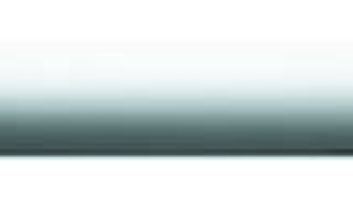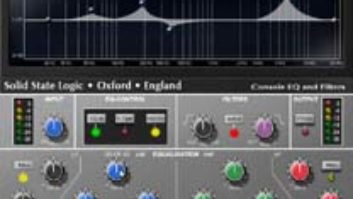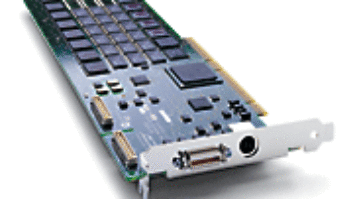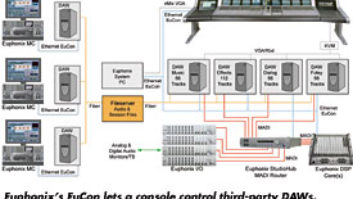
Soundscape has been in existence since 1993. Two years ago, Mackiepurchased Sydec, Soundscape’s Belgian parent, which meant highervisibility and more users on this side of the Atlantic. As a result,original Soundscape and Paris owners have, for a limited time, a $2,500trade-in credit that can be applied to a new Soundscape-32 system.
I first reviewed Soundscape in 1994, and I purchased two systems(eight tracks each) and then upgraded both to 12 channels plusreal-time effects. The fact that the system is still running on aPentium and only last summer did software development —which had been running concurrently with Soundscape-32 — reachthe limit of the hardware is testimony to the system’s foundation.Compared to that old hardware, Soundscape-32 adds eight tracks andhigher resolution, in half the rackspace, with the familiarinterface.
Soundscape-32 ($6,500 list) is a 2U hardware-dedicated workstationthat supports resolution up to 96 kHz/24-bit. You might be fooled byits intuitive and uncluttered design, but Soundscape has an underlyingpower and flexibility that make even a modestly endowed PC rock ‘n’roll. I’ve been mixing 24 tracks to 5.1 on original Soundscape hardwaresince 1998 on a system that is still a reliable performer. My focus forthis review is the Mixpander DSP Card; it raises the bar on processingheadroom, kinda like dropping a hydrogen-powered V-8 into a Volkswagen.So pop open the sunroof and transport yourself to the AutoStrada ’causewe’re headed for Tuscany with the hammer down. (That’s my fantasy;substitute as necessary.)
DOWN ON THE FARM
The ability to add DSP is not exclusive to Soundscape: Pro Tools hasFarm cards, and companies like Mackie and Universal Audio (UAD-1) andTC Works (PowerCore) manufacture cards for native-based systems.Mixpander not only increases Soundscape’s power, but it also opens 16bidirectional portals into native programs like Cubase, Cool Edit Proand GigaSampler. Unlike host-based software, Soundscape doesn’t careabout computer power; it can tolerate a computer crash and continue toplay through it.
Within the system, latency is extremely low. Even with lots ofprocessing, it’s only up about a dozen samples at 44.1 kHz, translatingto 0.27 milliseconds. When interfacing with host-based programs,Mixpander’s driver contributes about 1.5 ms, going and coming.
Though I have experience with this product, not every new featurecould be tested, so I tried something unusual: posting a message and arequest for feedback on the Soundscape message board. Because aworkstation can be many things to many people, I wanted to learn howthe system is used and what features are important to users. One usermentioned that Spindelay’s ASIO FX processor allows users to access awhole range of VST plug-ins; another reminded me of the integratedvideo player, which I tested.
MOVE THIS: IMPORT
Soundscape-32 can also import and export Pro Tools projects; whilemy testing was not comprehensive in this area, I learned that the PTsession need to be saved on the Mac side with PC compatibility. Theemphasis here is on the word “session,” which includes thefile that will restore all of the audio tracks to their proper locationwith whatever accompanying tweaks. The Import feature cannot readindividual audio files unless they have been saved in a PC-compatibleformat like “.WAV”; although with some experimentation, Iwas able to do this with Cool Edit Pro. My request would be forSoundscape to make the Import feature more transparent, capable ofopening both session and sound files from other programs, regardless ofplatform.
TESTING, 1, 2, 3
Software installation was fast and mostly easy. The program itselffits on two floppy discs, as do most of the plug-ins, although nofloppies were actually used — everything was downloaded from theNet. The newly updated and released operations manual is the largestfile; compiled from plenty of real-world experience, it’s extremelydetailed and comprehensive.
While it was unnecessary to run Soundscape on a dual-Celeron system,the pair of 21-inch monitors was the deciding factor: I find dualmonitors a necessity for all workstations. (This is especially true forSoundscape, which has two primary windows: an Arrange window displayingaudio tracks and automation, and a Mixer window with two modes, wideand narrow. A multitrack session mixer can easily fill a 16:9 monitorin either mode, a future upgrade for sure.)
Once the hardware was installed and happy, I formatted a new 60-gigdrive the slow way. There is a quick-format mode, but I just wanted tosee how long it would take. Let’s just say that the process startedbefore the sun went down and didn’t finish before midnight. Meanwhile,I already had plenty of sessions on the old system, and all werewithin 3% of exhausting the available resources. Because the goal wasto test Soundscape-32 with Mixpander, it seemed a practical place tostart.
My old system consisted of two 12-channel boxes linked together. Myhabit of using only one drive per unit turned out to be quiteserendipitous: The two drives slid into Soundscape-32 and mountedtransparently. All of the project folders, sound files, arrangements(session files) and mixer files appeared in the File Manager window.Two clicks, and the tracks and mixer appeared; only the second set of12 tracks needed to be reassigned at the mixer. I was quickly up andrunning.
IN SESSION
My recording project started life as a 24-track ADAT session. Out ofnecessity, I have become quite adept at conserving resources, sculptingwonderful 24-track to 5.1 and stereo mixes, albeit to outsiderecorders. Before, there was not enough “extra” DSP to adda single TC Dynamizer or a reverb during a 24-track mixdown. (I often“captured” reverb and saved multiband processing for themastering stage.) With Soundscape-32 and Mixpander, I had a Dynamizeron the main mix, as well as a submix of the snare and room tracks. Twokick tracks and a bass were subgrouped and mildly peak-limited usingthe Soundscape dynamics processor, which I love for its visualtranslation of the work being done. The 4-band equalizer is not new,but is such an improvement over its 2-band predecessor in terms ofsonics and features. The mix-in-progress was nowhere near tapping outthe system, so reverbs, Dynamizers and EQs were randomly addedeverywhere. The system never ran out of gas, and I noticed resourceoptimization balanced the load on each DSP chip each time a new plug-inwas added. I could become very spoiled.
With the exception of the initial hardware installation —which included tweaking the location of the various PCI cards alongwith a beta version of the software — the system did not crashduring three weeks of testing. I used Version 3.6 exclusively. No soundfiles were ever lost, and there are 99 levels of undo, although thelatter consumes memory and, used to excess, can slow the system downalthough I never experienced this. To demonstrate how robust the systemis, I opened Adobe Premiere and simultaneously played a video projectwhile Soundscape played a 24-track automated mix. There were noglitches, no hiccups and no complaints from either program.
HARDWARE CONTROL
Automation and control-surface options deserve mention becauseMackie has probably done more to push development in this area than anyother company has since its aquisition of Soundscape. Randomly matingcontrollers and workstations yields mixed results and often minimalfunctionality. You expect the faders, mutes and transport controls towork. But plug-ins vary greatly and present a challenge to developers.That’s why Mackie’s claim that its control interfaces seamlessly withSoundscape-32 is so encouraging.
I think it would be great if a little DIY software package wasincluded with every controller and workstation so that users with lotsof time on their hands can bring all of the pieces together. As withLINUX, people should be able to contribute their work toward the commongood. Meanwhile, back in reality land, I tested Soundscpe-32 with CMLabs’ Motor-Mix, focusing on faders, balance, mute and transportcontrols because those were the required tasks at that project’s stage.My only request is to be able to access Console Manager from more thanjust the mystery icon at the bottom-right corner of Window’s SystemTray.
WISH LIST
My requests are, er, simple. Soundscape has great potential as amastering tool. Quite often, I put each “item” on its ownpair of tracks and stereo fader. Placing ID flags from 101 upwardtranslate into track-start IDs via the burning package. The onlytrouble is, the package does not recognize a multitrack session, whichadds several extra steps to the process and extra reverse steps ifchanges need to be made.
I’d also like to be able to burn CDs in real time from the Arrangewindow to either a stand-alone CD burner or the computer’s burner. Myother request is for a stereo mixer module with a width control, frommono to hard-panned. Stereo modules require less desktop space,simplifying level, EQ, effects and dynamics linking for trackpairs.
FINALE
I have always loved the power of workstations. Soundscape-32 justhappens to be perhaps the most reliable workstation that behaveslike a piece of dedicated hardware. (Because it is.)
For the amount of potential time that can be spent on a session,especially considering musicians’ fees and their pricelessperformances, stability becomes one of the best features and thebiggest selling points for any product, specifically Soundscape-32.And, while I generally shy away from user groups, I must say that theSoundscape crew is a responsive and helpful bunch. Go to the“Support” section of www.soundscape-digital.com and ask them yourself.People who have this system swear by it, not at it.
THE HARDWARE RUNDOWN
INS AND OUTS
Unlike many systems that provide only a digital interface (which mayalso be proprietary), Soundscape-32 includes basic analog I/O —stereo-in and 4-channel-out — perfectly suited for basic audioproduction and sound-for-picture applications. Digital I/O comes in twoflavors: AES and TDIF. The AES I/O replicates the analog connections(plus Word Clock I/O); in addition, these portals can be independentlyrouted. The three TDIF connectors can directly interface with Tascam’sDTRS products (DA-X8 Series of tape machines), Soundscape’s 8-channelI/O boxes or your own preference of digital conversion. (That’s 24channels plus the analog and AES inputs.) MIDI I/O for timecode is partof the package; options include SMPTE timecode I/O and RS-422/9-pinsupport.
FOUR-CAR GARAGE
A flip-down front panel reveals two hard drive caddies that acceptstandard IDE drives. (There are two internal IDE hard drive bays, aswell.) Each bay supports up to 137 GB, providing over half-a-Terabyte(548 GB) of storage capacity. Soundscape-32 is capable of 32 tracks of24-bit recording at 44.1 kHz/48 kHz, half as many tracks at 88.2 kHz/96kHz.
CONTROL AND EXPANSION
For processor-intensive applications such as multitrack musicproduction, an Expansion port links Soundscape-32 to Mixpander. Thereare two PCI card options with an additional five or nine DSP chips. Ofcourse, I chose the 9-chip card! Two systems can be controlled from asingle PCI interface card — up to four hardware units max —totaling 128 simultaneous audio tracks at standard resolution. Thesystem can also be controlled via a printer port and a special“EPP” cable that is handy for portable applications vialaptop.

Screenshot Gallery:
Soundscape’s Dialog Mixer Window

EDL Processor

A variety of plug-ins are available.

The new and improved crossfade window

Soundscape 32’s enhanced surround capabilities

Soundscape’s video editing features

Want more? Clickhere to find out Eddie Ciletti puts Soundscape’s power inperspective.




